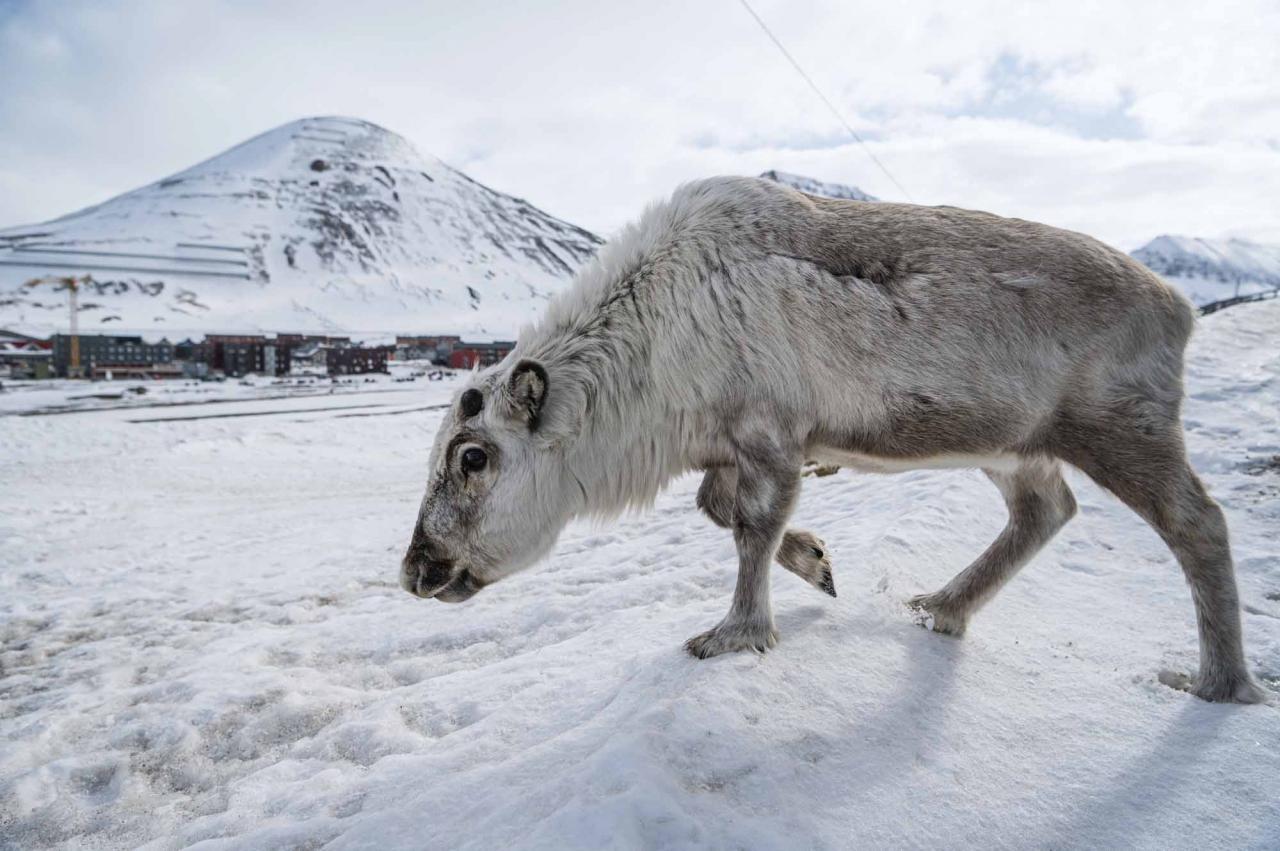Comment profiter d’une nature immaculée sans lui nuire? Haut perché dans l’Arctique, un archipel norvégien cherche à jouer la carte du tourisme durable, une piste aussi séduisante que complexe à mettre en oeuvre.
A 1.300 kilomètres du pôle Nord, le Svalbard (ou Spitzberg), c’est l’aventure polaire à portée d’un simple vol de ligne: immensités sauvages à couper le souffle, ours blancs, soleil de minuit ou aurores boréales selon les saisons… Mais, dans une région qui se réchauffe trois fois plus vite que la planète, c’est aussi, comme le canari dans la mine, une inquiétante vitrine du changement climatique.

Sur l’archipel où 65% des espaces sont protégés, les quelque 140.000 visiteurs annuels (chiffres pré-Covid) doivent, à l’instar des 3.000 habitants, se plier à des règles strictes: interdiction de déranger la faune –traquer un ours polaire est passible d’une grosse amende– ou de cueillir des fleurs sur ces terres où la végétation est rare… « On est vraiment face à la nature en fait, on n’a plus beaucoup d’espaces comme ça », témoigne Frédérique Barraja, une photographe française rencontrée à l’aéroport. « Ca attire comme tout lieu rare. Après, ils restent fragiles, donc il faut les visiter de manière respectueuse ».
Au fil des années, les filons de charbon, la raison d’être historique de la présence humaine sous ces latitudes, ont presque tous fermé et le tourisme est devenu, avec la recherche scientifique, l’un des principaux piliers et employeurs de l’économie locale. « C’est toujours difficile à défendre parce qu’on sait que le tourisme soulève des défis dans tous les endroits que les gens visitent mais aussi d’un point de vue climatique », admet Ronny Brunvoll, directeur de Visit Svalbard, l’association des professionnels du tourisme. « Mais on ne peut empêcher les gens de voyager, de se rendre visite, alors il faut trouver des solutions », ajoute-t-il.
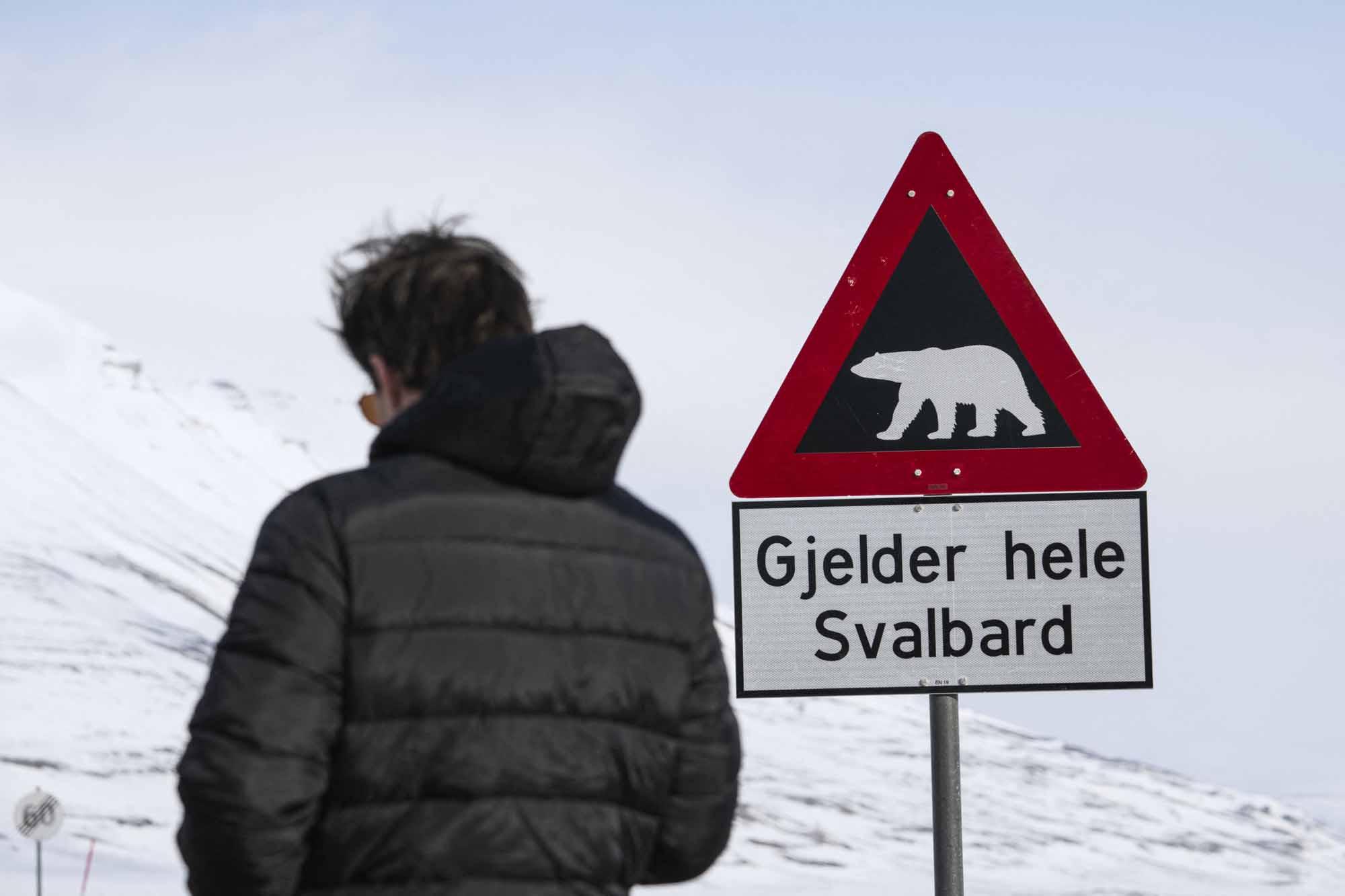
Ultra polluant, le fuel lourd, communément utilisé par les gros bateaux de croisière, est banni des eaux de l’archipel depuis le début de l’année, avant même l’entrée en vigueur de son interdiction progressive dans l’ensemble de l’Arctique à compter de 2024.
Sans doute un autre clou dans le cercueil pour ces mastodontes des mers décriés, qui débarquent parfois jusqu’à 5.000 passagers à Longyearbyen, le modeste chef-lieu de l’archipel dont les infrastructures, de la voirie jusqu’aux toilettes, ne sont pas dimensionnées pour de telles foules.
L’électrique, c’est fantastique
Dans un secteur touristique tourné vers une clientèle plutôt exclusive, certains acteurs devancent ou vont au-delà de la réglementation, tel Hurtigruten qui s’est fixé l’ambition d’être « le voyagiste le plus écologique au monde ». La durabilité « ne devrait pas être un avantage compétitif », affirme un haut responsable du groupe, Henrik Lund. « Cela devrait juste être un ticket d’entrée pour pouvoir opérer ».
Ayant banni le plastique jetable dès 2018, le tour-opérateur offre aujourd’hui des promenades en motoneige électrique et, depuis peu, des excursions en mer à bord d’un petit bateau hybride diesel-électrique novateur, le Kvitbjørn (« ours blanc » en norvégien). « Sur les sites d’exploration idylliques, on passe au tout-électrique, on devient silencieux et on n’émet aucune fumée de combustion », vante Johan Inden, président de la division maritime du motoriste Volvo Penta.
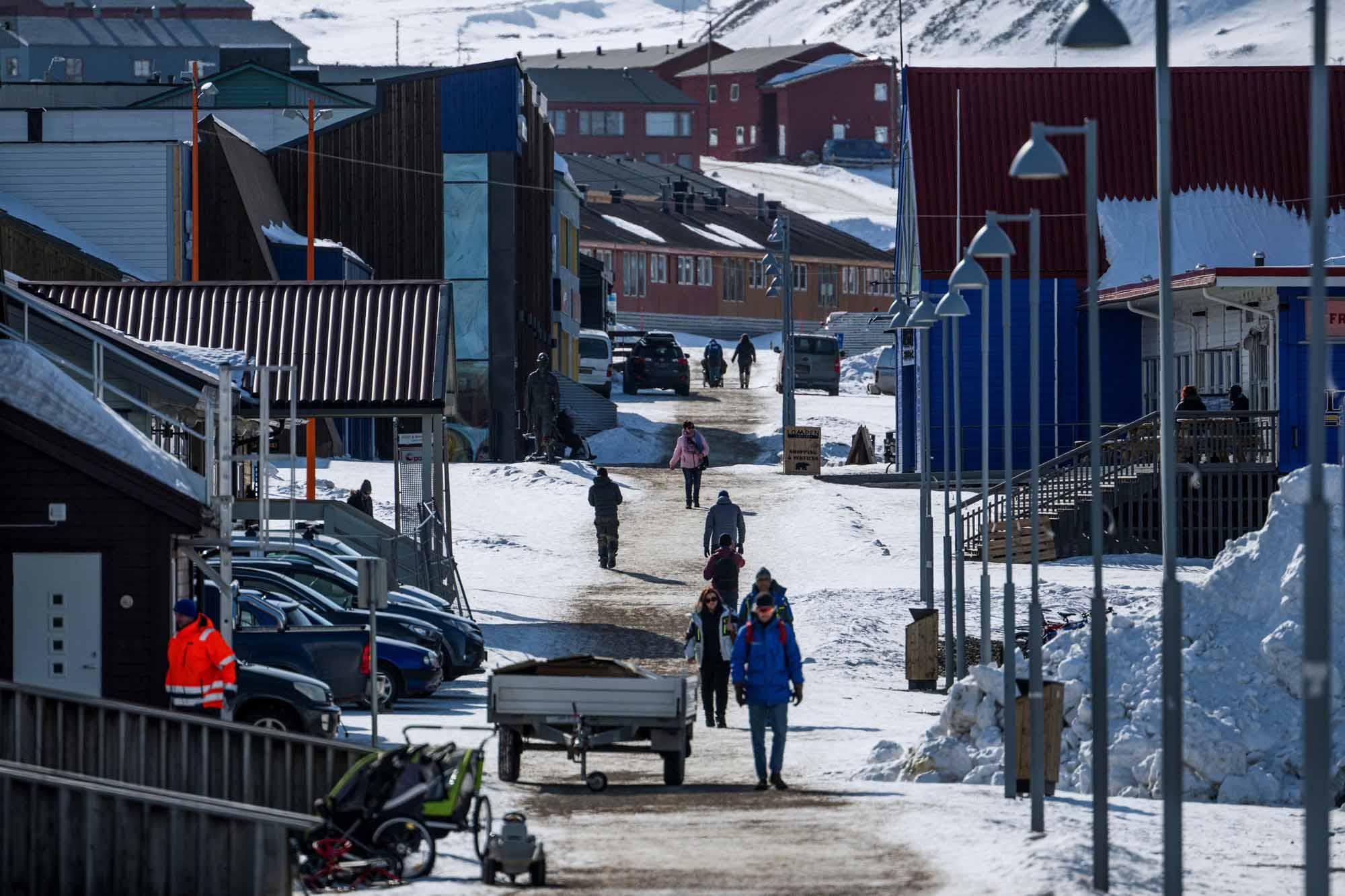
Un petit bémol cependant: au Svalbard, l’électricité provient encore d’une centrale au charbon, source d’énergie fossile qui contribue au réchauffement climatique. « L’électrification a du sens quelle que soit la source d’énergie », rassure Christian Eriksen, un responsable de l’ONG environnementale norvégienne Bellona.
Qu’il provienne de sources « sales » ou « propres », l’électrique « permet de toute façon de réduire les émissions », souligne-t-il, en invoquant une étude sur les voitures électriques concluant en ce sens. Mais « cette réduction sera sensiblement plus importante quand la centrale à charbon sera remplacée ». Un jour qui ne saurait tarder: Longyearbyen veut fermer sa polluante centrale d’ici à l’automne 2023, mettre le paquet sur les énergies renouvelables et réduire ses émissions de 80% d’ici à 2030.
Mais « on peut faire ce qu’on peut localement, y compris sur les émissions de motoneiges ou de voitures, il faut reconnaître que le vrai gros problème, c’est le transport vers et depuis Svalbard tant pour le tourisme que pour nous, locaux, qui vivons ici », dit M. Brunvoll.
« A Longyearbyen, nous avons une empreinte climatique par habitant qui est démente ».
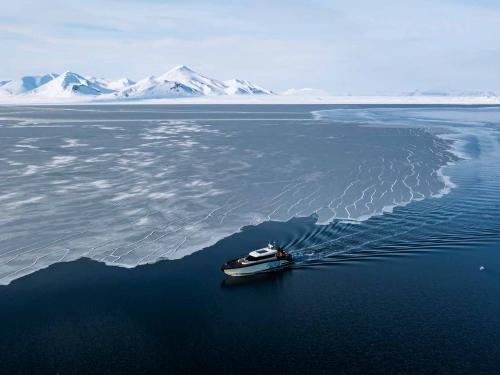
1/14
This aerial view image taken on May 3, 2022 shows the Kvitbjorn (Polar Bear, in Norwegian), a hybrid touristic boat, combining a diesel motor and electric batteries, as it makes its way in the sea ice in the Borebukta Bay, located at the northwestern side of Isfjorden, in Svalbard Archipelago, northern Norway. (Photo by Jonathan NACKSTRAND / AFP)

2/14
The Gruve 7, the last coal mine still in operation in Norway, is pictured near Longyearbyen on May 4, 2022, on the Svalbard Archipelago, northern Norway. (Photo by Jonathan NACKSTRAND / AFP)
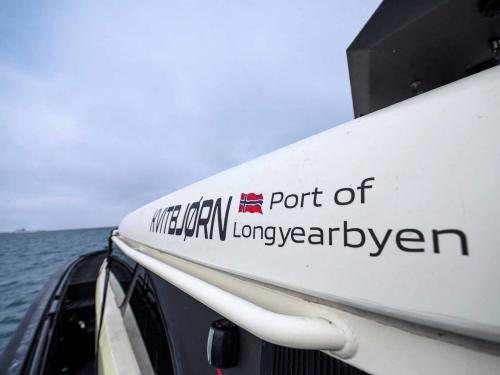
3/14
This picture taken on May 3, 2022, shows the Kvitbjorn (Polar Bear, in Norwegian), a hybrid touristic boat, combining a diesel motor and electric batteries, as it makes its way in the sea ice in the Borebukta Bay, located at the northwestern side of Isfjorden, in Svalbard Archipelago, northern Norway. (Photo by Jonathan NACKSTRAND / AFP)
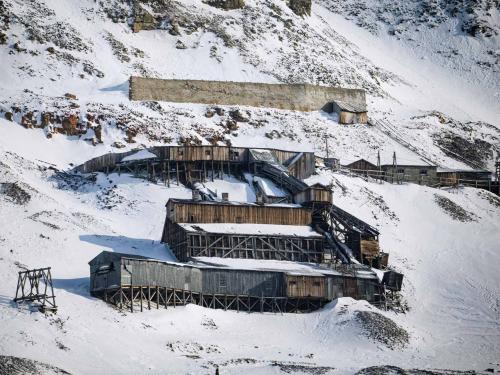
4/14
The defunct coal mine, Gruve 4, is pictured in Longyearbyen on May 2, 2022, on the Svalbard Archipelago, northern Norway. – Home to polar bears, the midnight sun and the northern lights, a Norwegian archipelago perched high in the Arctic is trying to find a way to profit from its pristine wilderness without ruining it. The Svalbard archipelago, located 1,300 kilometres (800 miles) from the North Pole and reachable by commercial airline flights, offers visitors vast expanses of untouched nature, with majestic mountains, glaciers and frozen fjords. Or, the fjords used to be frozen. Svalbard is now on the frontline of climate change, with the Arctic warming three times faster than the planet. (Photo by Jonathan NACKSTRAND / AFP)
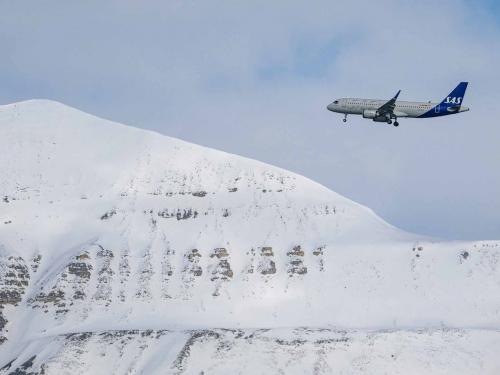
5/14
(FILES) In this file photo taken on May 6, 2022 a SAS airplane prepares to land at Longyearbyen airport, located on Spitsbergen island, Svalbard Archipelago, northern Norway. – Home to polar bears, the midnight sun and the northern lights, a Norwegian archipelago perched high in the Arctic is trying to find a way to profit from its pristine wilderness without ruining it. The Svalbard archipelago, located 1,300 kilometres (800 miles) from the North Pole and reachable by commercial airline flights, offers visitors vast expanses of untouched nature, with majestic mountains, glaciers and frozen fjords. Or, the fjords used to be frozen. Svalbard is now on the frontline of climate change, with the Arctic warming three times faster than the planet. (Photo by Jonathan NACKSTRAND / AFP)

6/14
(FILES) In this file photo taken on May 6, 2022 a reindeer is pictured in Longyearbyen, on Spitsbergen island, Svalbard Archipelago, northern Norway. – Home to polar bears, the midnight sun and the northern lights, a Norwegian archipelago perched high in the Arctic is trying to find a way to profit from its pristine wilderness without ruining it. The Svalbard archipelago, located 1,300 kilometres (800 miles) from the North Pole and reachable by commercial airline flights, offers visitors vast expanses of untouched nature, with majestic mountains, glaciers and frozen fjords. Or, the fjords used to be frozen. Svalbard is now on the frontline of climate change, with the Arctic warming three times faster than the planet. (Photo by Jonathan NACKSTRAND / AFP)

7/14
A man is pictured standing next to a warning sign depicting a polar bear at the side of a road near Longyearbyen on May 2, 2022, on the Svalbard Archipelago, northern Norway. – Home to polar bears, the midnight sun and the northern lights, a Norwegian archipelago perched high in the Arctic is trying to find a way to profit from its pristine wilderness without ruining it. The Svalbard archipelago, located 1,300 kilometres (800 miles) from the North Pole and reachable by commercial airline flights, offers visitors vast expanses of untouched nature, with majestic mountains, glaciers and frozen fjords. Or, the fjords used to be frozen. Svalbard is now on the frontline of climate change, with the Arctic warming three times faster than the planet. (Photo by Jonathan NACKSTRAND / AFP)
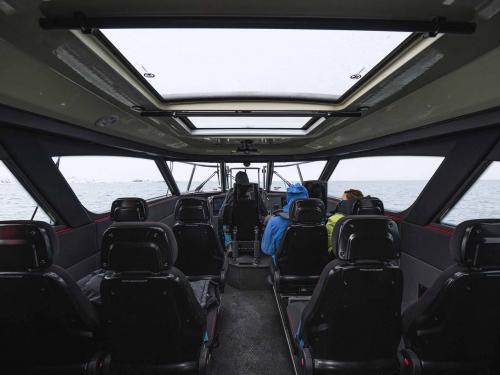
8/14
This picture taken on May 3, 2022 shows the inside of the Kvitbjorn (Polar Bear, in Norwegian), a hybrid touristic boat, combining a diesel motor and electric batteries, as it makes its way in the sea ice in the Borebukta Bay, located at the northwestern side of Isfjorden, in Svalbard Archipelago, northern Norway. – Home to polar bears, the midnight sun and the northern lights, a Norwegian archipelago perched high in the Arctic is trying to find a way to profit from its pristine wilderness without ruining it. The Svalbard archipelago, located 1,300 kilometres (800 miles) from the North Pole and reachable by commercial airline flights, offers visitors vast expanses of untouched nature, with majestic mountains, glaciers and frozen fjords. Or, the fjords used to be frozen. Svalbard is now on the frontline of climate change, with the Arctic warming three times faster than the planet. (Photo by Jonathan NACKSTRAND / AFP)

9/14
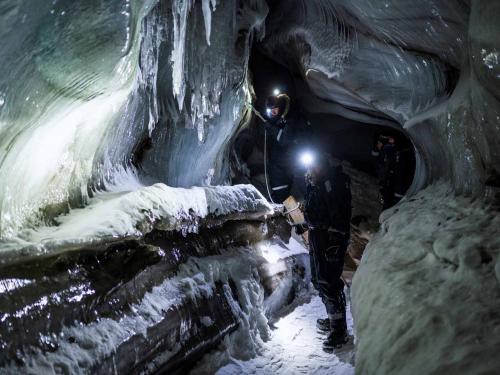
10/14
(FILES) This file photo taken on May 7, 2022 shows tourists visiting an ice cave inside Larsbreen Glacier, near Longyearbyen, on Spitsbergen island, Svalbard Archipelago, northern Norway. – Home to polar bears, the midnight sun and the northern lights, a Norwegian archipelago perched high in the Arctic is trying to find a way to profit from its pristine wilderness without ruining it. The Svalbard archipelago, located 1,300 kilometres (800 miles) from the North Pole and reachable by commercial airline flights, offers visitors vast expanses of untouched nature, with majestic mountains, glaciers and frozen fjords. Or, the fjords used to be frozen. Svalbard is now on the frontline of climate change, with the Arctic warming three times faster than the planet. (Photo by Jonathan NACKSTRAND / AFP)
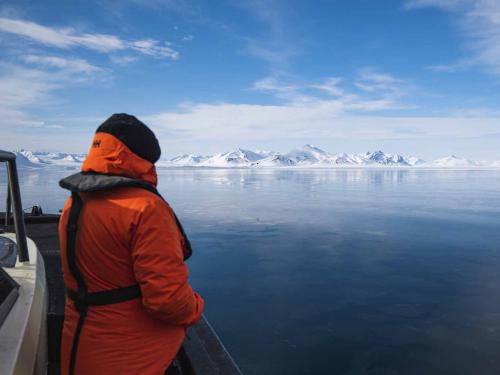
11/14
Un passager sur le Kvitbjorn
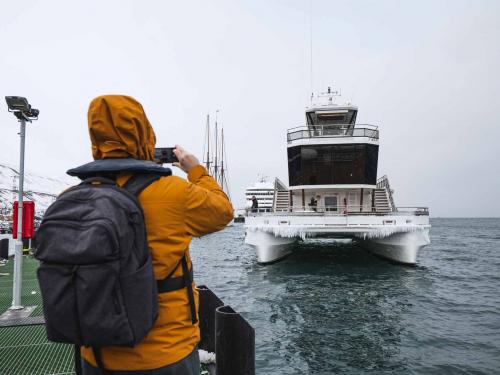
12/14
A tourist takes photos of a hybrid touristic boat as it approaches to the harbour in Longyearbyen, on May 3, 2022 on the Svalbard Archipelago, northern Norway. – Home to polar bears, the midnight sun and the northern lights, a Norwegian archipelago perched high in the Arctic is trying to find a way to profit from its pristine wilderness without ruining it. The Svalbard archipelago, located 1,300 kilometres (800 miles) from the North Pole and reachable by commercial airline flights, offers visitors vast expanses of untouched nature, with majestic mountains, glaciers and frozen fjords. Or, the fjords used to be frozen. Svalbard is now on the frontline of climate change, with the Arctic warming three times faster than the planet. (Photo by Jonathan NACKSTRAND / AFP)
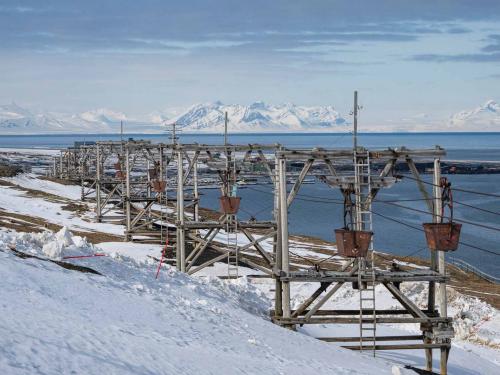
13/14
Conveyor towers once used for transporting coal from the mines to the harbour, are pictured in Longyearbyen on May 6, 2022, on the Svalbard Archipelago, northern Norway. – Home to polar bears, the midnight sun and the northern lights, a Norwegian archipelago perched high in the Arctic is trying to find a way to profit from its pristine wilderness without ruining it. The Svalbard archipelago, located 1,300 kilometres (800 miles) from the North Pole and reachable by commercial airline flights, offers visitors vast expanses of untouched nature, with majestic mountains, glaciers and frozen fjords. Or, the fjords used to be frozen. Svalbard is now on the frontline of climate change, with the Arctic warming three times faster than the planet. (Photo by Jonathan NACKSTRAND / AFP)
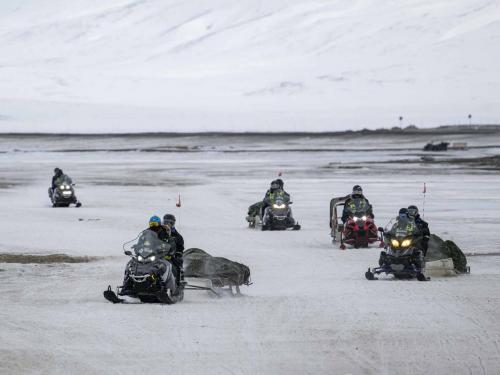
14/14
(FILES) In this file photo taken on May 08, 2022 Tourists come back to Longyearbyen after a tour on snow mobiles, on May 8, 2022, on Spitsbergen island, in Svalbard Archipelago, northern Norway. – Home to polar bears, the midnight sun and the northern lights, a Norwegian archipelago perched high in the Arctic is trying to find a way to profit from its pristine wilderness without ruining it. The Svalbard archipelago, located 1,300 kilometres (800 miles) from the North Pole and reachable by commercial airline flights, offers visitors vast expanses of untouched nature, with majestic mountains, glaciers and frozen fjords. Or, the fjords used to be frozen. Svalbard is now on the frontline of climate change, with the Arctic warming three times faster than the planet. (Photo by Jonathan NACKSTRAND / AFP)

1/14
This aerial view image taken on May 3, 2022 shows the Kvitbjorn (Polar Bear, in Norwegian), a hybrid touristic boat, combining a diesel motor and electric batteries, as it makes its way in the sea ice in the Borebukta Bay, located at the northwestern side of Isfjorden, in Svalbard Archipelago, northern Norway. (Photo by Jonathan NACKSTRAND / AFP)

2/14
The Gruve 7, the last coal mine still in operation in Norway, is pictured near Longyearbyen on May 4, 2022, on the Svalbard Archipelago, northern Norway. (Photo by Jonathan NACKSTRAND / AFP)

3/14
This picture taken on May 3, 2022, shows the Kvitbjorn (Polar Bear, in Norwegian), a hybrid touristic boat, combining a diesel motor and electric batteries, as it makes its way in the sea ice in the Borebukta Bay, located at the northwestern side of Isfjorden, in Svalbard Archipelago, northern Norway. (Photo by Jonathan NACKSTRAND / AFP)

4/14
The defunct coal mine, Gruve 4, is pictured in Longyearbyen on May 2, 2022, on the Svalbard Archipelago, northern Norway. – Home to polar bears, the midnight sun and the northern lights, a Norwegian archipelago perched high in the Arctic is trying to find a way to profit from its pristine wilderness without ruining it. The Svalbard archipelago, located 1,300 kilometres (800 miles) from the North Pole and reachable by commercial airline flights, offers visitors vast expanses of untouched nature, with majestic mountains, glaciers and frozen fjords. Or, the fjords used to be frozen. Svalbard is now on the frontline of climate change, with the Arctic warming three times faster than the planet. (Photo by Jonathan NACKSTRAND / AFP)

5/14
(FILES) In this file photo taken on May 6, 2022 a SAS airplane prepares to land at Longyearbyen airport, located on Spitsbergen island, Svalbard Archipelago, northern Norway. – Home to polar bears, the midnight sun and the northern lights, a Norwegian archipelago perched high in the Arctic is trying to find a way to profit from its pristine wilderness without ruining it. The Svalbard archipelago, located 1,300 kilometres (800 miles) from the North Pole and reachable by commercial airline flights, offers visitors vast expanses of untouched nature, with majestic mountains, glaciers and frozen fjords. Or, the fjords used to be frozen. Svalbard is now on the frontline of climate change, with the Arctic warming three times faster than the planet. (Photo by Jonathan NACKSTRAND / AFP)

6/14
(FILES) In this file photo taken on May 6, 2022 a reindeer is pictured in Longyearbyen, on Spitsbergen island, Svalbard Archipelago, northern Norway. – Home to polar bears, the midnight sun and the northern lights, a Norwegian archipelago perched high in the Arctic is trying to find a way to profit from its pristine wilderness without ruining it. The Svalbard archipelago, located 1,300 kilometres (800 miles) from the North Pole and reachable by commercial airline flights, offers visitors vast expanses of untouched nature, with majestic mountains, glaciers and frozen fjords. Or, the fjords used to be frozen. Svalbard is now on the frontline of climate change, with the Arctic warming three times faster than the planet. (Photo by Jonathan NACKSTRAND / AFP)

7/14
A man is pictured standing next to a warning sign depicting a polar bear at the side of a road near Longyearbyen on May 2, 2022, on the Svalbard Archipelago, northern Norway. – Home to polar bears, the midnight sun and the northern lights, a Norwegian archipelago perched high in the Arctic is trying to find a way to profit from its pristine wilderness without ruining it. The Svalbard archipelago, located 1,300 kilometres (800 miles) from the North Pole and reachable by commercial airline flights, offers visitors vast expanses of untouched nature, with majestic mountains, glaciers and frozen fjords. Or, the fjords used to be frozen. Svalbard is now on the frontline of climate change, with the Arctic warming three times faster than the planet. (Photo by Jonathan NACKSTRAND / AFP)

8/14
This picture taken on May 3, 2022 shows the inside of the Kvitbjorn (Polar Bear, in Norwegian), a hybrid touristic boat, combining a diesel motor and electric batteries, as it makes its way in the sea ice in the Borebukta Bay, located at the northwestern side of Isfjorden, in Svalbard Archipelago, northern Norway. – Home to polar bears, the midnight sun and the northern lights, a Norwegian archipelago perched high in the Arctic is trying to find a way to profit from its pristine wilderness without ruining it. The Svalbard archipelago, located 1,300 kilometres (800 miles) from the North Pole and reachable by commercial airline flights, offers visitors vast expanses of untouched nature, with majestic mountains, glaciers and frozen fjords. Or, the fjords used to be frozen. Svalbard is now on the frontline of climate change, with the Arctic warming three times faster than the planet. (Photo by Jonathan NACKSTRAND / AFP)

9/14

10/14
(FILES) This file photo taken on May 7, 2022 shows tourists visiting an ice cave inside Larsbreen Glacier, near Longyearbyen, on Spitsbergen island, Svalbard Archipelago, northern Norway. – Home to polar bears, the midnight sun and the northern lights, a Norwegian archipelago perched high in the Arctic is trying to find a way to profit from its pristine wilderness without ruining it. The Svalbard archipelago, located 1,300 kilometres (800 miles) from the North Pole and reachable by commercial airline flights, offers visitors vast expanses of untouched nature, with majestic mountains, glaciers and frozen fjords. Or, the fjords used to be frozen. Svalbard is now on the frontline of climate change, with the Arctic warming three times faster than the planet. (Photo by Jonathan NACKSTRAND / AFP)

11/14
Un passager sur le Kvitbjorn

12/14
A tourist takes photos of a hybrid touristic boat as it approaches to the harbour in Longyearbyen, on May 3, 2022 on the Svalbard Archipelago, northern Norway. – Home to polar bears, the midnight sun and the northern lights, a Norwegian archipelago perched high in the Arctic is trying to find a way to profit from its pristine wilderness without ruining it. The Svalbard archipelago, located 1,300 kilometres (800 miles) from the North Pole and reachable by commercial airline flights, offers visitors vast expanses of untouched nature, with majestic mountains, glaciers and frozen fjords. Or, the fjords used to be frozen. Svalbard is now on the frontline of climate change, with the Arctic warming three times faster than the planet. (Photo by Jonathan NACKSTRAND / AFP)

13/14
Conveyor towers once used for transporting coal from the mines to the harbour, are pictured in Longyearbyen on May 6, 2022, on the Svalbard Archipelago, northern Norway. – Home to polar bears, the midnight sun and the northern lights, a Norwegian archipelago perched high in the Arctic is trying to find a way to profit from its pristine wilderness without ruining it. The Svalbard archipelago, located 1,300 kilometres (800 miles) from the North Pole and reachable by commercial airline flights, offers visitors vast expanses of untouched nature, with majestic mountains, glaciers and frozen fjords. Or, the fjords used to be frozen. Svalbard is now on the frontline of climate change, with the Arctic warming three times faster than the planet. (Photo by Jonathan NACKSTRAND / AFP)

14/14
(FILES) In this file photo taken on May 08, 2022 Tourists come back to Longyearbyen after a tour on snow mobiles, on May 8, 2022, on Spitsbergen island, in Svalbard Archipelago, northern Norway. – Home to polar bears, the midnight sun and the northern lights, a Norwegian archipelago perched high in the Arctic is trying to find a way to profit from its pristine wilderness without ruining it. The Svalbard archipelago, located 1,300 kilometres (800 miles) from the North Pole and reachable by commercial airline flights, offers visitors vast expanses of untouched nature, with majestic mountains, glaciers and frozen fjords. Or, the fjords used to be frozen. Svalbard is now on the frontline of climate change, with the Arctic warming three times faster than the planet. (Photo by Jonathan NACKSTRAND / AFP)





